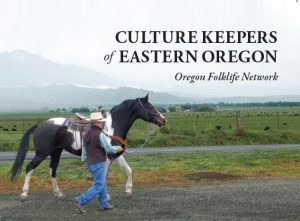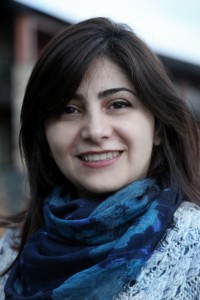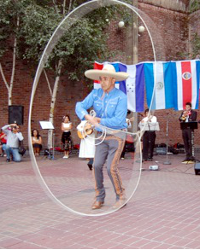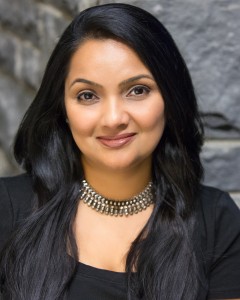Brad McMullen
 From April 20th-22nd, the Oregon Folklife Network hosted the annual Association of Western States Folklorists meeting. This gathering brings together public folklorists throughout the American West to discuss their current work and learn new skills. This year was especially exciting because the Western States Folklore Society (WSFS) also had its annual conference in Eugene, a planned convergence that encouraged public and academic folklorists to come together and share ideas.
From April 20th-22nd, the Oregon Folklife Network hosted the annual Association of Western States Folklorists meeting. This gathering brings together public folklorists throughout the American West to discuss their current work and learn new skills. This year was especially exciting because the Western States Folklore Society (WSFS) also had its annual conference in Eugene, a planned convergence that encouraged public and academic folklorists to come together and share ideas.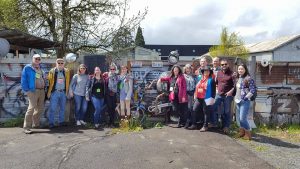
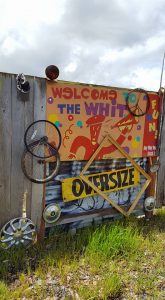 AWSF kicked off with a cultural heritage tour of Eugene’s Whiteaker neighborhood. The tour was loosely organized around the impacts of gentrification for community arts and craft businesses and
AWSF kicked off with a cultural heritage tour of Eugene’s Whiteaker neighborhood. The tour was loosely organized around the impacts of gentrification for community arts and craft businesses and  residents. At Falling Sky Delicatessen, the group enjoyed generous and delicious tastes of and tips about fermented foods. Chair of the Whiteaker Community Council, Sam Hahn, led folks on walking tour of the
residents. At Falling Sky Delicatessen, the group enjoyed generous and delicious tastes of and tips about fermented foods. Chair of the Whiteaker Community Council, Sam Hahn, led folks on walking tour of the  neighborhood and visit to Blairally Vintage Arcade, where our visiting folklorists learned about pinball culture and the restoration of old pinball
neighborhood and visit to Blairally Vintage Arcade, where our visiting folklorists learned about pinball culture and the restoration of old pinball  machines. Next, the group popped in to Thinking Tree Spirits, a newly opened distillery where a tour of the distillation facilities and samples of craft vodka and gin cocktails were on
machines. Next, the group popped in to Thinking Tree Spirits, a newly opened distillery where a tour of the distillation facilities and samples of craft vodka and gin cocktails were on 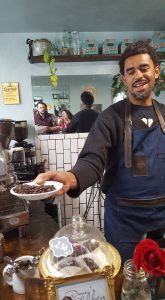 the menu. A visit with Equiano Coffee’s owner/coffee roaster, Okon Udosenata, provided an insider’s view of artisanal coffee roasting plus some aromatic sips
the menu. A visit with Equiano Coffee’s owner/coffee roaster, Okon Udosenata, provided an insider’s view of artisanal coffee roasting plus some aromatic sips  Chris Paulson’s fused glass studio entranced everyone with its beautiful displays and Paulson’s stories about his work. Our final stop was at Ninkasi Brewing, where the group learned about the “brewshed” and Ninkasi’s history in the Whiteaker neighborhood.
Chris Paulson’s fused glass studio entranced everyone with its beautiful displays and Paulson’s stories about his work. Our final stop was at Ninkasi Brewing, where the group learned about the “brewshed” and Ninkasi’s history in the Whiteaker neighborhood.
Our joint AWSF and WSFS conferences came together at the start with a memorial screening of Carol Spellman’s For the Love of the Tune: Irish Women and Traditional Music and moving tributes to Carol and her work. Next on the agenda was a joint session on the Future of Folklore, which OFN executive director, Riki Saltzman, facilitated. With speakers from as far as American Folklife Center in Washington D.C., and as local as Native storyteller Patricia Whereat Phillips, the panel discussed where the field of folklore is going and how to best prepare folklorists for the future. After lunch, a panel of alumni from the University of Oregon’s Folklore graduate program shared ways in which they applied their folklore skills in a variety of workplace settings. Attendees were happy to see how people are both engaging with and expanding the field of folklore. UO librarian Nathan Georgitis provided an overview of best practices and a rundown of useful tools for managing a folklore archive.
 Highlights from the final day of the conference included Shirod Younker (Coquille/Miluk Coos), who provided an in-depth and engaging presentation on Native perspectives on and contemporary programming in traditional arts. Younker also shared some of his own art and spoke about his involvement with the A. Susana Santos’ Journeys in Creativity Program at Oregon College of Art and Craft. In another session, OFN’s Lyle Murphy and Indiana University’s Kelly Totten discussed their work with incarcerated populations. AWSF closed with Bodeene Amyot’s workshop on photographic skills, which was filled with great examples and tips for how to best use your camera to take fantastic photographs. Amyot is a gifted photographer and visual storyteller.
Highlights from the final day of the conference included Shirod Younker (Coquille/Miluk Coos), who provided an in-depth and engaging presentation on Native perspectives on and contemporary programming in traditional arts. Younker also shared some of his own art and spoke about his involvement with the A. Susana Santos’ Journeys in Creativity Program at Oregon College of Art and Craft. In another session, OFN’s Lyle Murphy and Indiana University’s Kelly Totten discussed their work with incarcerated populations. AWSF closed with Bodeene Amyot’s workshop on photographic skills, which was filled with great examples and tips for how to best use your camera to take fantastic photographs. Amyot is a gifted photographer and visual storyteller.
The meeting created critical time for folklorists to engage with each other on projects and issues all share in common and to strategize about growth and sustainability in our field. OFN is grateful for funding from UO’s Academic Affairs and the UO Folklore Program as well as the American Folklore Society’s Professional Award.
